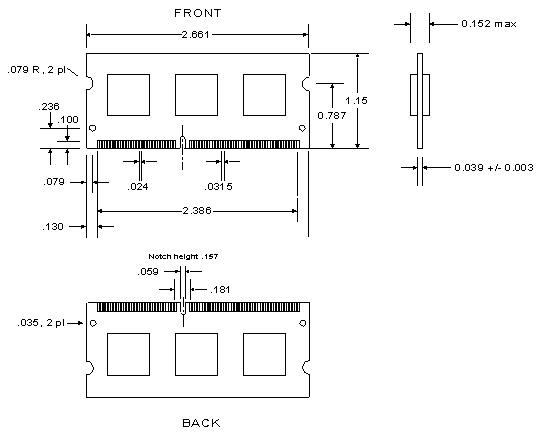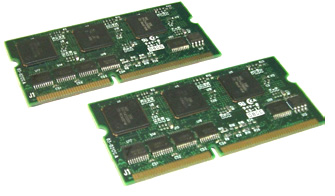Home :: Products & Services
:: Hardware:: Modules
:: DSP Modules:: SigC542x-SODIMM
SigC542x-SODIMM DSP Module
Overview
SigC542x-SODIMM plug-in modules provide multiprocessor DSP and voice solutions for telecom, telephony and call processing, Internet routing, and network infrastructure applications. The modular approach to parallel DSP processing offers higher density and performance, lower-cost, and several advantages for OEM products:
base-board design is simplified and fabrication risk is decreased modules can be upgraded easily, as faster and more capable DSP devices become available; Signalogic's DSP module roadmap supports a variety of module types and densities for custom applications, it is straightforward to specify a module with fewer processors and more memory, or vice versa SigC54xx modules are supported by standard, off-the-shelf software tools, including DirectDSP, Hypersignal-Macro, and Code Composer Studio software
Applications for SigC54xx plug-in modules include base-station processing, VoIP (Voice-over Internet protocol) networking functions, telephony and call processing functions, VoDSL (voice-over DSL), Internet routing, multiple-channel speech or audio code / decode (e.g. G.711, G.723, G.729A or MELP speech compression and MP3 audio compression), modem banks, and speech recognition.
The modular approach is particularly well-suited to providing a scalable solution for telecom and Internet equipment applications that require a massive number of DSP devices. For example, voice channel capacity upgrades can be performed in the field.
SigC542x-SODIMM Feature Summary
True 1200 MIPs (1.2 GIPs) performance Very small form-factors, 2.75" x 1.25", fits into 144-pin SODIMM socket
Up to twelve (12) total 100 MHz C5420 or C5421 cores, in six (6) 144-pin GGU packages, each with separate 1.8v core and 3.3v peripheral voltages. Partial number of DSPs may be populated 100k x 16 (5420) or 192k x 16 (5421) zero-wait-state onchip SRAM per core 128 byte "cookie data" serial EEPROM option available on module; 12C signals available at module edge Supported by SigC54xx Development System compatible with
DirectDSP®, Hypersignal®-Macro development, measurement, and test software (see below) 16-bit HPI host-port, TDM / buffered serial port, external interrupt, and reset signals available at module edge; both multiplexed and non-multiplexed HPI modes are available JTAG signals are chained between DSPs and available at module edge 4-channel audio CODEC SODIMM module also available
Specifications and Data Sheet
SigC542x-SODIMM Data Sheet (108 KB)
SigC542x-SODIMM Development Tool Support
Application-specific software, Signalogic software, Telogy software and other DSP code and algorithm development, integration, and debug on the SigC542x-SODIMM module is supported using two main methods:
multiple DSP access from host software via HPI interface at module edge; examples include DirectDSPâ and VDSä software (also known as "algorithm level debug") JTAG 1149.1 debug interface fully compatible with Texas Instruments Code Composer Studio software (also known as "chip level debug"
Host software support includes Win9x, Win2k, or Linux device drivers and access from standard PC development environments (C/C++, MATLAB, .NET) via DirectDSP software. DirectDSP provides high-speed bulk data transfer, executable file download in COFF format to single or multiple DSPs, symbolic DSP code/data reference from high-level languages, example DSP source code, and default DSP functions and operating modes. The DirectDSP interface is complementary to JTAG and offers additional development and debug advantages; for example:
DSP processors do not have to be stopped or paused to transfer data, as with JTAG DSP source code does not have to be "instrumented", or otherwise modified
DirectDSP software may be used simultaneously with Code Composer Studio software to provide both algorithm level and chip level debug capabilities. The two packages are fully complementary.
The DirectDSP API includes low-level hardware control functions such as reset/run/hold, register access, block memory transfer, DSP executable file download, etc. High-level functions include waveform file acquire/generate, continuous signal generation and execution of any arbitrary Hypersignal DSP or math function. DirectDSP includes strip-chart recorder, digital oscilloscope and digital tape recorder demo program and source code examples.
Using the DirectDSP software interface, C54xx processors do not need to be held or otherwise delayed when host software accesses onchip SRAM, and DSP source code does not need to be altered or "instrumented" in any way.
In addition to DirectDSP software, the SigC542x-SODIMM module is supported by Signalogic off-the-shelf tools designed for voice-over-packet and DSP algorithm system development, analysis, and measurement, including VDS and Hypersignal software packages.
These off-the-shelf tools, which also support other C54xx platforms such as SigC54xx and PC/104 boards, SigC5561-PTMC card, high-density telecom modules in other formats, and Texas Instrumentsâ DSK C54xx boards, are described below.
VDS™ (Voice-over-packet Development System) Software is an integrated environment that includes numerous development, analysis, measurement, test debug, and simulation functions for developing VoIP and VoATM systems.
The VDS environment combines both simulation and real-time operating modes. It includes support for several types of off-the-shelf DSP hardware, including SigC544x PTMC and PCI cards and systems, SigC54xx and SigC55xx multiprocessor telecom modules, and Texas Instruments® DSK boards.
VDS test and measurement features include both packet analysis and packet impairment. Packets may deliberately be impaired with a variety of error types in order to debug and measure performance system components such as jitter buffer and echo canceller. The VDS environment and architecture supports operation as a fully automated test system.
Individual voice and audio processing components within VDS may be configured either as DSP software (DSP Mode, running on supported DSP hardware), or as host PC software components (Host Mode). Within the VDS user-interface, software components can be easily configured as DSP Mode or Host Mode in various combinations. This flexible and interactive configuration facilitates both development and analysis phases of VoIP and VoATM projects.
VDS includes network-side and telephony-side configuration and management. Voice software settings include CODEC type, echo canceller, jitter buffer, silence suppression, real-time parameters, and packet impairment test and measurement options. Voice software selections made from the GUI directly set properties in the Telogy voice software running in real-time on the C54xx DSP devices.
Packet impairment options include arbitrary delay, jitter, frame erasure, bit and burst errors, random, repeat, and pattern timing options. Voice/data I/O options include file, TDM, and analog.
Packet communication protocol support includes UDP/IP, RTP, RTCP, and TCP/IP (fax protocol).
Physical media configuration includes network (modem, DSL, LAN), and synchronous serial (RS-485, HDLC).
Hypersignal®-Macro and Hypersignal-Acoustic Software Series offer a number of simulation and real-time instrument functions. Simulation functions include DSP and math functions, time domain display (including waterfall, contour, magnitude, unwrapped phase), difference equation, digital FIR and IIR filter design, sampling rate conversion, frequency zoom, wavelet transform, minimum phase calculation, and many more. Instrument functions include spectrum analyzer, digital oscilloscope, stimulus & response measurement, continuous signal generation, real-time; "snap-in"; filtering, continuous disk record and generate, and more.
C54xx Source Code Interface Software contains numerous C54xx algorithms and functions in source and binary form, such as optimized FFTs, filters, matrix, transcendental, trig, signal manipulation function, processor and card initialization and analog I/O examples, etc. These functions form the basis of higher-level software functions and instruments; modification can be used to customize Hypersignal or DirectDSP software operation. User-defined C routine hooks are provided for real-time algorithm development. The C54xx Source Code Interface can be used as a basic foundation for user-defined real-time DSP systems and products.
SigC542x-SODIMM Module Mechanical Drawing

|





